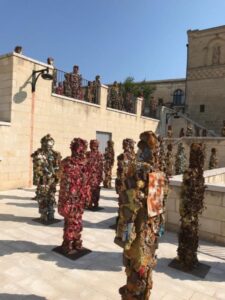
In the evening, Matera is like a Christmas creche; when the sun sets and many small lights come on in the “Sassi”, cave dwellings that have existed since the Paleolithic period. The effect is striking. Matera, in the Basilicata region (proclaimed European Capital of Culture for 2019) has been renewed today. It was included in the UNESCO World Heritage List in 1993, but has experienced alternate phases in its history. Until 1950 for about two centuries it was considered the national disgrace of Italy, symbol of the backwardness of southern Italy. Men and animals (the valuable donkey was always present) lived in dark caves, illuminated by a single chink of light that came in from the opening of the caves in a bleak promiscuity. Today, rehabilitated thanks to intelligent integration policies in the area, it is experiencing a period of great fervor; many tourists from all over the world visit it every year, attracted by its particular geological conformation (it rises on a “gravina”, a high cliff on a ravine) and by its cave churches, dug into the rock and with many ancient frescoes.
In August, when I visited it, the city throbbed with energy and had numerous exhibitions all over. Among the events I attended, the most original was the “Trash People” installation by the German artist HA Schult. One thousand anthropomorphic statues, placed during the night, surprisingly appeared on a clearing in front of the Sassi and the ravine. The “men” of this army, made of pieces of rubbish, looked like sentinels guarding an unchanging and ancient place, soldiers protecting the natural beauty of the territory.
Their bodies are made of trash: old tin cans, pieces of rubbish, plastic, car parts, computer components or electrical equipment. Each sentinel is different from each other, but they are all made of unnoble materials, the trash produced by man.
HA Schult (Hans-Jurgen Schult), conceptual artist, has brought his army made of trash around the world since 1996, from the Great Wall of China to Moscow, from the Pyramids in Giza to New York, all the way to the Antarctic. His message could not be clearer: trash has reached even the most remote corners of the Earth, its elimination requires increasingly more investments if we do not want to be submerged by 2,503 million tons per year (2014 figure) produced by economic and domestic activities in the EU.
The care of the place where we live, of which we are not the owners but only the custodians, must be tackled immediately and from an early age, as the youth of the “Fridays for future” movement started by Greta Thunberg remind us. If we continue to wait, the environmental crisis will be past the point of no return.
This is also the task of art and of the artists most sensitive to this problem today. HA Schult, bringing the installation to Matera, wants to enhance the beauty of an enchanting place, warning us against possible contaminations.
The trash men, 1.80m tall, who stand impassively and colorfully in front of us, are the symbol of our inability to live on Earth in a lighter, less cumbersome way. Looking at them, the Chinese terracotta army in the Qinshihuang Mausoleum comes to mind, but in our case the material is quite different.
From the place where they were initially placed, the Trash People will move to various parts of the city, in groups or all together, to raise awareness of the spectators, captured by the colorful and playful, but at the same time disturbing presence, of the statues. They are travelers, tourists who move from one place to another on the planet, silent but implacable messengers of human and environmental discomfort.
At the end of October, when most of them will go directly to other destinations, twenty of them, called “Matera People”, made by HA Schult with local stone and tuff dust, will remain in the city, bearing witness to the beauty of art and nature of this unique city.
Liviana Martin
Volume 34 no.2 November/December 2019 pp 34-35
